March 2020 Wrapup!
Well now.
Hasn’t this been a thing.
What happened here, on this blog?
Well, Kenny Rogers died, which interrupted my scheduled articles and I found myself looking very hard at myself and the person that, in no small part, Kenny helped shape. I wasn’t happy with what I saw. I finally penned a reference point to show people what fanagement was about. The weirdly popular Claw Gloves article went up – I blame Freyja and her gang of accessorisingly extra cat people. The wrapup of the Round Pokemon thread went up, and I liked that. I took the 3rd Edition D&D Epic Level Handbook to task, and that was fun.
On a small bummer, also I put up an article – which I was very proud of – about Hatsune Miku’s song Odds n Ends, which didn’t get a lot of attention or reaction. The Vocaloid contingent must not respond to things the way the Touhou Project contingent do.
This month’s shirt is coincidentally well timed, and to my surprise, has the shortest time between releasing the shirt and someone buying it of anything I’ve made: It took a day before someone bought a shirt of this design.

This month’s video is kind of a packing peanut. See, I had two other videos in mind, and a third in script stage – but none of them could be easily or conveniently made, which meant that it was extremely hard to get them done in the time frame I needed. Which means you get this, a half hour tour of my current big Minecraft project: A great big hole in the wall keep.
Personal life… well.
Classes started up again, and two weeks in, we decided to shift to online classes. Then the conversation about whether or not we do that became compulsory, and then things got real. I’m already a creature inclined to spend weeks at a time in my own house – just the way I prefer to be – and the effort of going out to do other things ran into that.
I can’t do much to help, but I can try to avoid giving anyone else stress. I won’t talk much about the situation here, because I think the last thing I should be doing is giving you all more reasons to feel anxious and distressed. We’re going to do our best to cope, and we’re going to do our best to take care of one another, together, all the time.
Okay?
See you tomorrow.
Story Pile: Son of a Son of a Sailor
The followup to Margaritaville And Some Other Songs was, to me, one half of a two-disc set that my dad got and taped so we could listen to it in the car. It’s a very literal album – some very clear, explicit stories told in song form, not a lot of subtle metaphor. This album, while definitely Another Jimmy Buffett Album and having a song or two on it I really like, is relatively brainless.
It’s got a song about liking cheeseburgers, a song about liking parties, another song about liking parties, and two songs about people he’s met, with a restful, relaxing pace to them. These are to me, the better songs on the album – Cowboy in the Jungle and African Friend are both songs that talk about other, interesting people, and their stories as Jimmy’s narrator only momentarily intersected with them.
It’s interesting, and infamously, Cheeseburger in Paradise is a weird classic of his, a song about… liking a cheeseburger.
Anywayyyy, uh
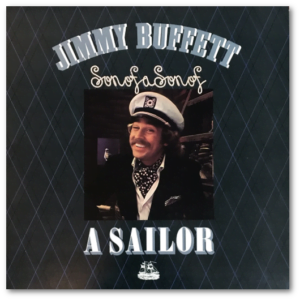
Falling Out Of Exploration Games
Hollow Knight’s a pretty cool game.
Don’t think I’ll finish it.
When I sat down to play Hollow Knight it was a really comforting experience, something I did because I knew I wanted to make a video, and I didn’t have the energy or mental effort to do a lot of editing. I played a bunch of Hollow Knight for that video, checked out how it looked, then went off to CanCon. When I got back, I played a little bit more Hollow Knight, then I took a little bit of a break. There was work that needed doing, so I didn’t play any videogames for a week or so.
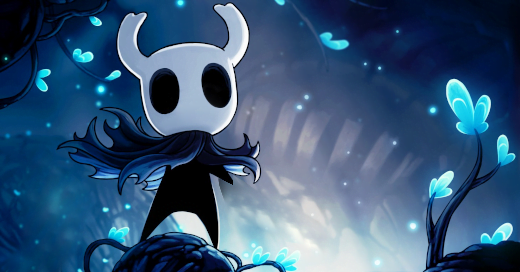
Then when I came back, and I want to make it clear, I was not far into Hollow Knight, I didn’t know what I was doing. Oh, the skills for combat were all there after a few moments of poking buttons. But the interface obscurity, the difficulty of working out what the map was doing, trying to find the path onwards, losing resources in trying to recover what happened…
I just stopped.
Exploration games are really popular amongst people who talk about games, stories, and storytelling via games. They’re kind of a beloved genre, and they do all these things that can make them feel more serious and more cinematic, or, you know, just that vague ‘better-er’ than games that don’t do those things. The experience melts into itself, so the sequence of the narrative needs to be reconstructed, and so many of these exploration games get to make you feel clever as you explore the game more, as you understand more. They also tend to be cryptic, without a specifically stated, clearly outlined narrative – it’s really easy to make things ambiguous when the play experience pulls you along, after all.
Time to time a new game will come out that does this. It’s a little understructured, it’s engaging in a way that keeps you going, without any chapter breaks or typical, clear direction. Horizon Zero Dawn and Dark Souls were both held up as examples of this type, where reviewers rhapsodied about how great it was that these games didn’t ‘hold your hand.’
These are people whose jobs involve being able to play the same game for sixteen hours and needing to stay engaged for the whole process. I, on the other hand, need to sometimes break from games sharply and immediately. Sometimes I need to take four or five day breaks from games to complete work tasks. Sometimes, I need to re-engage with a game because another project requires my attention, or I need something I can share or collaborate on.
The secret sauce that makes exploration games engaging curdles over time.
People Aren’t Problematic
A while back I was asked on curioscat, a question that cooked down to am I problematic because I enjoy media that is problematic? To that, at the time, I said:
The simple answer is no.
Continue Reading →Game Pile: Some More Minecraft
It’s been a tough month, and I’m sorry this isn’t more polished. This was made with other projects on the boil because it seemed the easiest thing to make that would get done. I hope you like looking at my castle.
5 Things That Actually Happen In Ranma 1/2
Ranma 1/2 was a weird anime, and its weirdness was magnified by its own stuttering success. I don’t know what the merchandising was like in the day, but the history of Ranma 1/2 is one of seemingly a sudden and yawning need to create more Ranma content. It’s an infamously filler-prone anime, which means that almost any story it did, it probably did twice. The anime invents characters and has a bunch of plot cul-de-sac stuff and the anime had lots of episodes and the fanfiction community created a lot of fanon that wound up becoming part of what people assumed was canon in the west.
For this reason it can be challenging to underscore just how weird the pre-existing Ranma 1/2 manga really is. It’s funny, because the fanon-framed, anime-infused vision of canon is actually less weird because everything that seems really weird gets filed as ‘filler stuff.’
Here then are five actual, no really, things that happened in the Ranma 1/2 manga.
Continue Reading →March Shirt: Big Mood
What do we have this month? Well, it wasn’t made to be any kind of trend chasing, I just felt like playing with a classic videogame logo, and now we have:
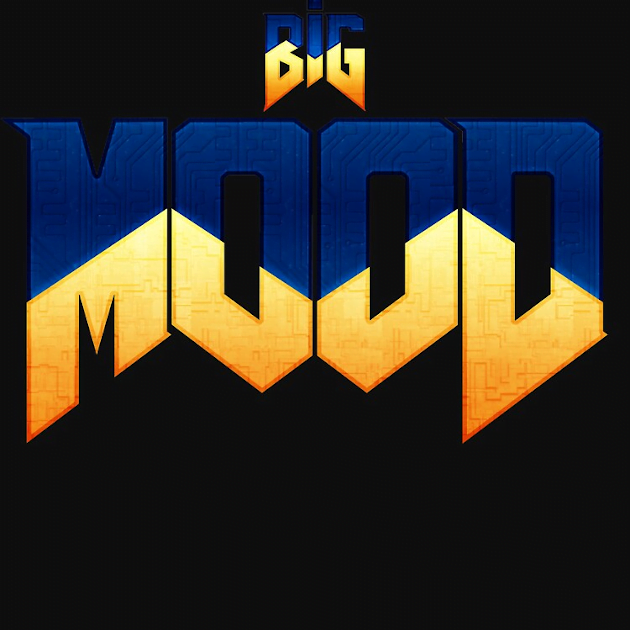
Here it is on a different supposedly unisex model over on Redbubble:
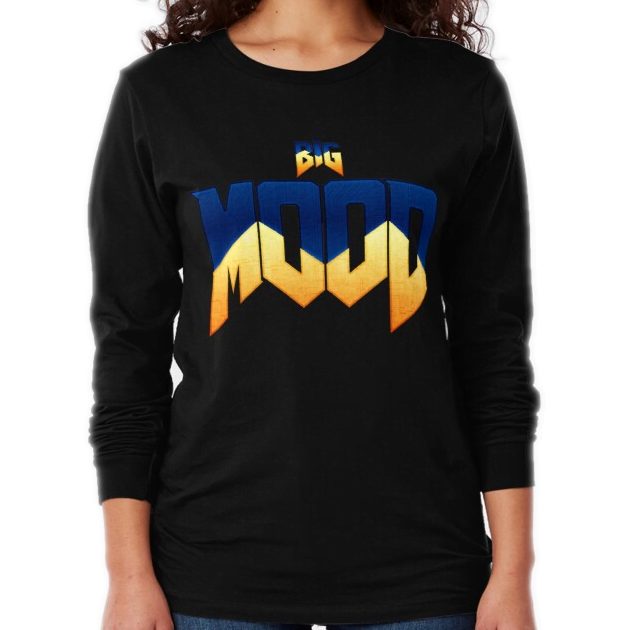
And here it is on the Teepublic ghost.
Like the shirt? Well, you would, wouldn’t you. You can go get it on Redbubble or Teepublic.
Enby Signalling In Superheroes
Hey, here’s a thing that I find difficult.
Content warning: I’m not nonbinary, and I’m going to talk about nonbinary identities. This is naturally fraught and I’m not going to pretend that I’m an expert, or that I can’t make mistakes. Cool? Cool.
Story Pile: Le Mans 1955
I was recommended to watch this short film on Youtube by my father, who is and has almost always been, an avid motorsports fan. Unlike many other Story Pile entries, this one, you can just press a button and watch it. You can watch the whole thing.
Le Mans 1955 is a 2018 short animated feature, made by a guy called Quentin Baillieux, along with no doubt, dozens of other people’s hard work. I’m not a French speaker, nor am I versed in the French animation scene so I can’t really get involved and say ‘oh, here’s the context for that,’ but I want you to be aware of the limits I have. I don’t know Baillieux, I don’t know the studio, this is very much just an area of my ignorance.
Hell, my ignorance runs deep on this one; I knew, vaguely, there were a bunch of crashes in motorsports history, but I didn’t know about this one. I can remember hearing of Ayrton Senna being killed in a crash when I was a young child, I can remember the horror of seeing my dad and uncle react to the news of Alex Zanardi being cut in half from a crash in 2000. Motorsports has been around me and never engaged me my entire life. What I mostly knew were these tragic, terrible incidents of someone just
being gone.
I was also growing up in the 90s, so the idea of the motorsports crash was heavily influenced by that – a period when safety standards had already been clamped down pretty hard and were going to clamp down further. I hadn’t looked into the grim history of the worst crashes, the worst audience fatalities, the worst this sport could be, and what could happen.
In 1955, one of the greatest motorsports disasters took place, where a track that wasn’t meant for cars to do this, where three bodies moving at high speed made reasonable but imperfect judgements and the result was a car moving at two hundred miles per hour flying through the air at such speed and with such force that it burst into flames and disintegrated, into a stadium full of spectators. Eighty people died. A hundred and eighty or so were injured.
This is a strange gem of culture. This is one of those periods of time when men were successfully carving out spaces for themselves. This is a point where a man retiring almost but not quite on top was a heavy weight, and it took eighty deaths and a hundred and eighty injuries for him to consider hey hang on maybe. This is a deeply relatable, painful moment, if you can connect with these men from a time when, in a space they had made for themselves and driven out all alternatives, they had to deal with the anguish that they normally relied on other people to handle.
It’s also about games.
The lead didn’t matter. Oh there were incentives, financial and reputation wise, there were some levels of stocks or investment or confidence or whatever that you could make out of winning the race, but winning the race versus placing second or fifth in the race was relatively meaningless. These were specialised subdivisions of companies that were showing they could push the idea of vehicle design to its absolute limit, but they were all systems of things. The nature of privilege for men, even in this period, was one where there were layers upon layers of protection and guarantee to keep you from being seriously hurt for failures. Nobody went to jail over Le Mans. Nobody got blamed.
The reason to care about your performance at Le Mans was because you cared about your performance at Le Mans.
In this movie, you see the emotions of men who cared about their performance at Le Mans so much that there was a struggle… a real tense struggle to be able to say no.
I have to stop the game.
People have died.
Thanks, Dad, this was a really good little movie, and I really appreciate being told about it!
The Gambler
Kenny Rogers just died.
For anyone not aware, Kenny Rogers was a Country Western singer whose career started before you think and was still going up until just a few years ago. In a way he was one of your pop-crossover one-hit wonders, thanks to a duet with Dolly-mother-freaking-Parton called Islands in the Stream, a song that gives her every opportunity to show off how awesome she is and how he can manage to Be Next To Her, which you know, when you’re dealing with the incandescent strange sun that is Dolly Parton, a woman who at that time in history was somehow managing to be a gator-wrangling country firecracker in the visual aesthetic of what can only be called Escaping The 80s Big Hair Bimbo Chic, it’s not so bad.
It’s not that he was a great man or a good man and I don’t say that because I’m thinking that there’s some well known fact about his life or how he stiffed the KFC Colonel out of reparations money or something weird like that but it’s just that these days I don’t feel comfortable sticking my neck out for any famous person I primarily know for having committed the act of being rich in their lifetimes. It’s entirely possible the dude was really great in his private life, but I don’t know that and I don’t feel like looking it up and picking over his moral character in his life through the pinhole of wikipedia now the dude’s died and I need to make that call in order for my Death Take to be apprporiately woke. What I can tell you based on observing the guy is that he had some fucked up boomer-ass opinions about women and relationships and the way he spent his later years pumping out Christmas albums and getting plastic surgery to stave off the Being In His Seventies suggested that he wasn’t particularly super happy with the enormously comfortable life of someone who owned multiple restaurants and was married for twenty-three years.
And despite all that, what’s super weird is that Kenny Rogers dying means a lot to me for no good reason. The internet has conditioned me to see every single thing in terms of a listicle and so with that, here are Three Things About Kenny Rogers I’ve Been Thinking About All Day as I Process the Death of a Fascinatingly Mediocre Successful Person.
3. The Gambler
This song is one of Kenny Rogers’ most famous, and I mostly see it invoked as a punchline. It’s a song about using a game to look at your own life, as a metaphor, and consider the lessons from a poker table that you can bring to bear on problems in life in general, and you know what startles me relistening to it again, after all this time, all over again?
This song gets poker right.
It’s so utterly baffling to me that this cheesy little song of a riverboat ridin’ ramblin’ man who generally never reached higher levels than an emotional sentment of I heart you and sometimes love, but hard? managed to convey in a song an actual meaningful metaphor based off a game that doesn’t break if you know how the game is played.
2. Coward of the County
Oh and content warning here! Sexual assault, misogyny, toxic masculinity!
This song was on a Kenny Rogers ‘best of’ compilation I listened to when I was a kid in the 90s. The album had a lot of songs I remember more for a crooning part of the chorus than anything of their content, and Kenny’s music is extremely samey at the best of times.
Anyway, uh, so, hey, this country song with a lilting tone and a back-and-forth beat is uhm, it’s about a gang rape? It’s about a woman who’s gang-raped by three men and how massively it traumatised her.
I mean, that’s not what the song is about. That’s just a detail in the song, a song that is otherwise about the classic story of a seemingly humble young man who refuses to fight people thanks to a promise his father asked him to make (and maybe he made it) finally being pushed too far because the worst thing that could happen to him was his girlfriend being gangraped. God, I try to repeat phrases like that to numb them of all their sense but you know this time I think I’m not going to do that. I didn’t realise at the time that that’s what ‘they took turns’ would mean. It was never explained to me, so that detail just… hung around until some twenty years later I thought back and went: Hang on, holy shit.
Anyway, this song is really fucked up and it fucked me up directly, because of a whole laundry list of personal traumas. Not the least of which was that my father made me promise that no matter how angry I’d get, I’d walk away from trouble and let people hurt me because that was the Christian way. I mean, it’s not like fighting would have fixed anything (because I tried that too) but the song kept hanging around in my mind with the idea that at some point, something bad would happen to me, and then that would be the point where God would make me a just and noble avatar of his anger and maybe it’d all be a good story, then, rather than a story about thirty years of crawling.
There’s also the fact that Tommy’s dad died in prison, something about which I had complex feelings. After all, Tommy’s dad wasn’t… around. He asked his son to meet a moral standard, and then… he left.
That was oddly comforting, a fantasy to have.
The whole of this story really impressed itself on me, as an idea of something I thought that should happen in my life. That’s pretty messed up.
1. Six Pack
Hey that was a bit dark, what about this? How about something unrelated? Well, Kenny Rogers was one of a number of country music ‘stars’ who moved into making movies that we can lightly refer to as ‘mid day TV fare.’ Six Pack was an attempt to make a kind of dad movie about a wannabe Stock Car racer with a broken heart bringing back his career from the brink and collecting a bunch of kids on the way.
This movie is definitely in that calibre of ‘good enough to be pirated on Youtube.’ It’s the kind of movie where even the people who own the copyright for it aren’t going to bother pulling it down because it’s not like they’re making profit off it some other way.
This movie was one of the first non-Christian non-kid-targeted movies I can remember watching. It wasn’t good, it wasn’t great… but it was there. It was a post on my personal timeline.
None of these works really matter to me now. None of them are good, I don’t recommend them to anyone. The place I was in, the person I was, the person who listened to these stories and who loved them and who thought that they were meaningful is gone, and I’d like to think I’m a much better person than I was then. I’m out of a space that was bad for me, and I would not recommend any of these works of stunning mediocrity to anyone.
But I still know all the words by heart.
MTG: Big Gulps
WOTC Employees: This article talks about unsolicited game designs, though it does not show any specific example cards.
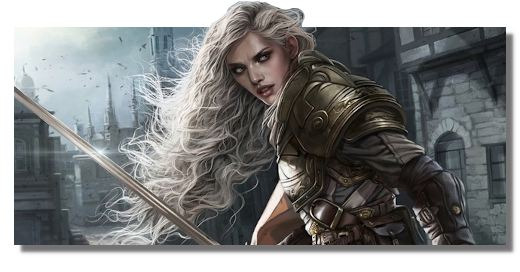
When it comes to custom magic card design, I’m something of a pain in the ass. I don’t find myself particularly adventuresome in design, and will generally look at things in terms of what space they’re opening up. The effect this has in the community is that I’m the one who’s generally going ‘maybe not this,’ and that can be a real bummer for people. Apparently, I’ve got a reputation for being unpleasable.
One of the topics that we’re – still – hammering on is White. The argument –
no, hang on, it’s a whine.
– is that white is weak and that we in the heroic custom magic mines know better than Wizards, and will produce the cards that ‘fix’ White that they’re too cowardly to print. I’m pretty regularly there to tell people why I don’t think their solutions are good (in my opinion), but I know I don’t often put my ideas out there.
Continue Reading →Game Pile: Star Realms Frontiers
Oh hey, Star Realms again! Didn’t I already wax lyrical about how much I liked this game?
Well, yes, I did! And the thing with this tiny little tight box of a game that lived on your phone (if you wanted it to) is that in addition to having a great core game, the people over at White Wizard kept making it. Over on BoardgameGeek, the interconnected wikipedia of people brave enough to ask ‘but who’s to say racism is bad per se?’ the nonetheless fantastically detailed database lists Star Realms as a game with 51 expansions.
Today, then, we’re going to look at at an expansion that doesn’t need the base game, otherwise known commonly as an expandalone, called Star Realms Frontiers.
Unicorn Co-op
I’ve had this card game in progress now for far too long.
The idea is a game where you’re constructing unicorns with interesting names from two halves. Half the cards are unicorn forequarters, the other half are… well there’s no proper term for them (that I’m going to bother looking up) so we just have to call them what they are. They’re unicorn butts.
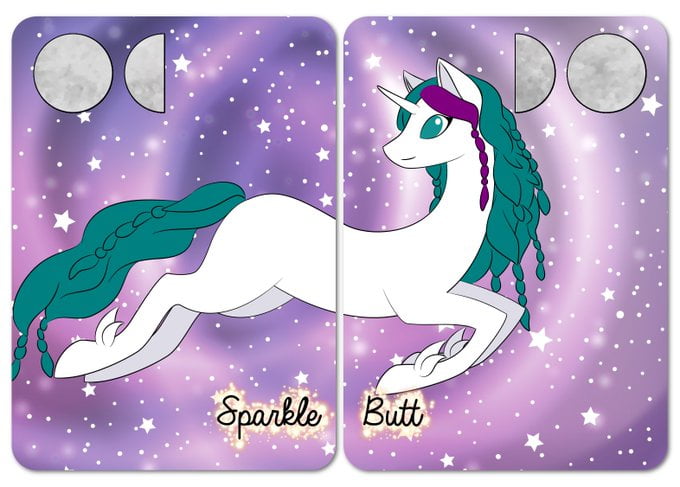
Once upon a time, this game started out as a simple, competitive game with two decks; you would play the cards, two at a time, either adding them to your herd of unicorns, or to an opponent’s herd of unicorns. The original idea was that they were just going to be math functions – so some unicorns would add some numbers, some would subtract some numbers. So you could put together a butt with a – and a head with a 4, and give it to your opponent, to give them -4. Honestly, that game is pretty doable and pretty easy – I might even hammer it out as a sort of pattern-puzzle matchy game for under-sixes sometime.
I wanted though to make this game cooperative, though, and since part of the reason to build a unicorn was to give it a funny/silly/goofy name, and if there were some cards with negative effects, that meant there’d be some unicorn name components that were always bad. Had to kick that one in the neck right away.
I’d also started by setting out 26 cards as butts and 26 cards as forequarters, and I know there’s a horse expert reading this and she’s so mad at my terminology. Anyway, in my attempts to redesign this game, I’ve tried to find a way to minimise that number, or maybe expand my options… and with that came a new idea.

The idea is that each unicorn card has a head, and a butt, on either side. At the start of the game, you put all the cards so the same face is up (say the butt, because butts are funny. You split that deck evenly in half, then flip it over, and shuffle them together. Now you have an even number of heads, and butts. This means that suddenly, my 26 head and 26 butt cards are 26 cards, meaning that the deck now has room for more unicorns (yay) and some other cards (which give me room to make a cooperative AI for the game).
This is a simple little mechanistic change of the game’s design, and now I’ve put it down somewhere I hopefully won’t fricking forget it.
Working Out Loud
Recently I was contacted by a blog reader – hi there! – who asked about how I got started, and what it entailed. How I built my following, that kind of stuff. What I told them at the time was that a lot of what I did was spend a large chunk of time trying things and watching as nothing happened.
It’s a real awkward thing to think about but as much as this blog readership isn’t large, it’s still much larger than it started. The economies of scale of blogging I learned about in university and examining Youtube suggest that attention needs to be in the order of thousands of people to be sustainable.
Back when Matt Lees started on Patreon, the Pivot To Video era was happening for gamer media, and that was when EuroGamer was doing videos in a lot of experimental ways. He said that the nature of that model relied on the idea that a video that got ten thousand positive reactions wasn’t good enough, wasn’t sustainable. That was always a thing that nagged at me, because that number was terrifying. I never had a problem with the thing I was making per se, as much as I had a problem with realising that even the best versions of the things I was making was simply never going to be interesting to ten thousand people.
As of right now, the most popular article I’ve ever written is Why Death Note Is Bad, which thanks to some people referencing it on forums, is high up on the list Google Hits for the phrase ‘is death note bad.’ Over six years, it has reached 8,000 views. My next most popular article is No Colour Is Transphobic, and then Amerimanga Covers. Those articles are much more recent, but they’re both sitting around 4,000 and 3,000 views. Now, one trend that’s promising there is that the more recent work is still capable of having high numbers of views!
What this means to me is that that number of ten thousand is simply not something I reach, or maybe ever can reach and that’s kind of okay? I’m alright with that (in part because I have to be). I’m also not saying that there aren’t ten thousand people interested in my kind of writing! I’m saying that my ability to find those people is pretty much just limited to randomly mentioning all the stuff I do.
This also queues into some predictable response things. Look, fact is, if you follow @FreyjaErlings, you’re more likely to click links she shares. That’s something about her audience that I just can’t replicate.
A few years ago I tried doing some Google Drive game development on a public document, where I sat down, and just wrote about things with complete strangers having the ability to comment on the doc as I worked on it. This scared the hell out of me because I was putting a google drive link on the open internet and was afraid that it was going to go weird or I’d wind up disclosing something that would go badly for me. Instead when I launched it, I worked on the doc for four hours and literally nobody ever looked at the document.
Similarly, my Long Live The Queen review scared me because I knew I was being exaggerated and silly (in a way I don’t really do well), and thought maybe it would become a meme and I’d feel humiliated by it. Instead I found that it’d been listened to twice – and by the way, in the intervening six years, it’s been listened to nineteen times.
This is a byproduct of how I try to think about working in public. There’s this idea that as an internet content creator, you’re looking for things you do that you can monetise. Alex Steacy has written about this – where for a lot of content creators, what they’re doing is trying to provide stuff they want to do that you can connect to and enjoy. That means that they play videogames as a job, and it changes the relationship to what they’re doing and that can sometimes mean that they’re left seeing game play as a very challenging task to get into emotionally.
Ever get so burned out on a game that even seeing the title screen annoys you?
That's how I've felt about Minecraft for the last couple years. Hard to want to make content when it takes so much energy to simply enjoy. I love making videos, but I can hardly stand the game…
— Jessassin (@Jessassin) October 8, 2018
I’m not sure I’m coming at this from the same place. In part because I don’t feel like what I do is in this same kind of attention driven, long engagement space – after all those beautiful people who are paying me to blog and make movies are doing it with no idea on what I’m going to do. Sometimes they get nine thousand words about how Magic The Gathering isn’t like Gacha and sometimes they get a shirt with a Shrek joke on it.
What I do, and what I think of myself as doing is working in public. I am doing things, making things, looking at things for my own benefit as a game designer and media critic, and trying to break down those elements to be workable and useful for me and for others. Oh sure, you might tune in for movie reviews (really? cool?), but largely what I’m doing here is thinking, and working out loud. I’m explaining to you things I’ve learned, and I’m trying to show you the process of how I develop things.
This is something that was important, to me, about working with this blogging space.
I want you to be able to learn from this, even if you are enjoying it.
That’s what works for me.
This isn’t to say that anyone else should be doing it! It’s just there’s this narrative that content creation is about turning love into work. It doesn’t have to be. Some of us, it’s a habit we keep up on as personal practice. Sometimes it’s journaling in private, sometimes it’s yeah, doing things for a sweet dopamine hit of approval!
There are lots of reasons to work out loud.
How To Be: Thor, from Marvel Comics (In 4E D&D)
In How To Be we’re going to look at a variety of characters from Not D&D and conceptualise how you might go about making a version of that character in the form of D&D that matters on this blog, D&D 4th Edition. Our guidelines are as follows:
- This is going to be a brief rundown of ways to make a character that ‘feels’ like the source character
- This isn’t meant to be comprehensive or authoritive but as a creative exercise
- While not every character can work immediately out of the box, the aim is to make sure they have a character ‘feel’ as soon as possible
- The character has to have the ‘feeling’ of the character by at least midway through Heroic
When building characters in 4th Edition it’s worth remembering that there are a lot of different ways to do the same basic thing. This isn’t going to be comprehensive, or even particularly fleshed out, and instead give you some places to start when you want to make something.
Another thing to remember is that 4e characters tend to be more about collected interactions of groups of things – it’s not that you get a build with specific rules about what you have to take, and when, and why, like you’re lockpicking your way through a design in the hopes of getting an overlap eventually. Character building is about packages, not programs, and we’ll talk about some packages and reference them going forwards.
This time, we’re going to try and capture the feeling of THE GOD OF THUNDER Thor from Marvel Comics.
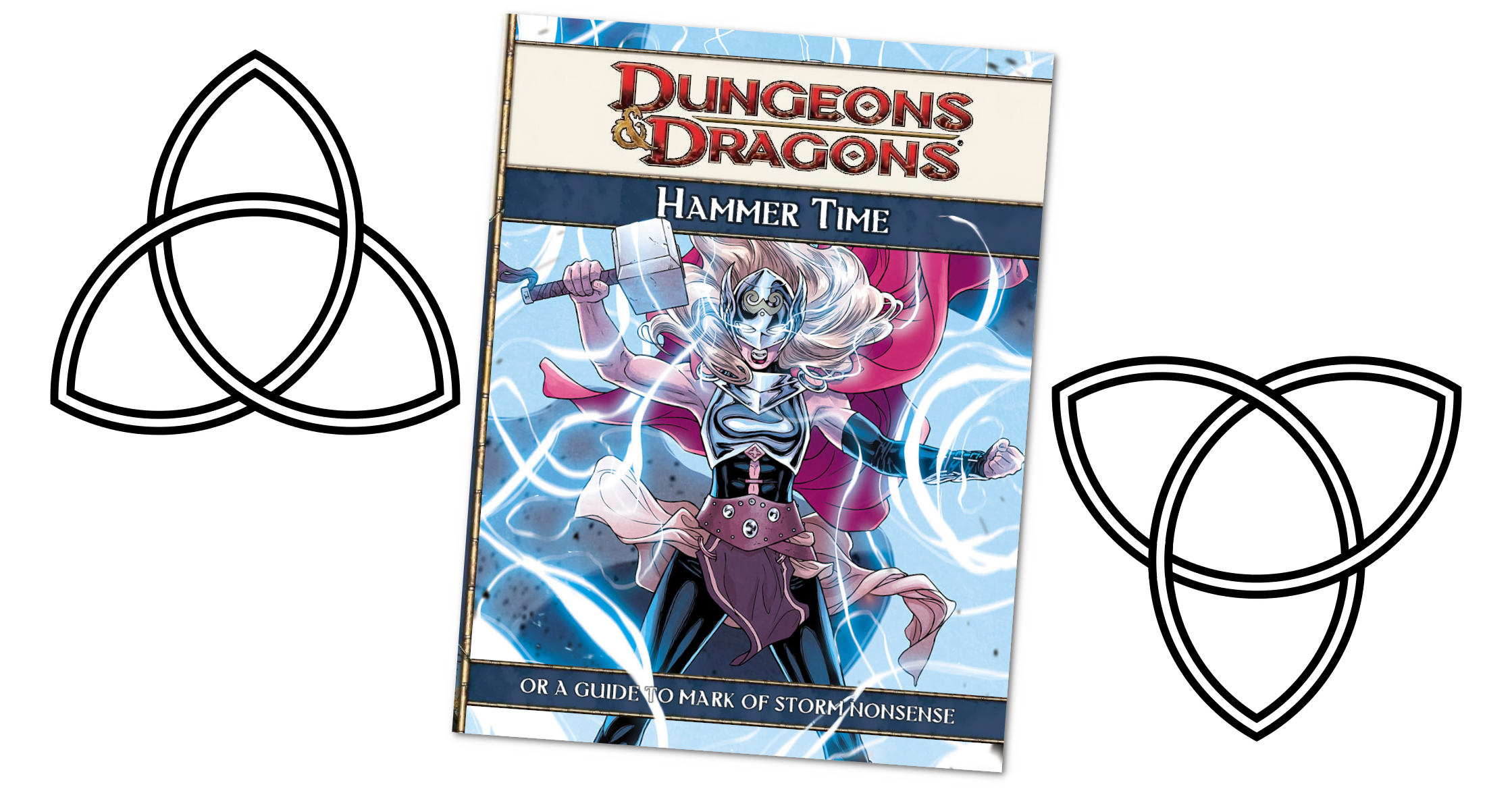
Story Pile: Changes in Latitudes, Changes in Attitudes
Now, look, odds are good listening to this music – if you have been – you may have found you like a few Jimmy songs. You might think that one or two of them are good, maybe the best songs on an album are worth sitting through. That’s fine. I don’t know why I respond to these songs the way I do. If you listen to this album and think ‘eh,’ that’s fine, but you should know that I play a game with this album with people where you take an album and ask how many songs you have to remove before the album’s not worth picking up.
On this ten song album, I think that you have to ditch nine of the songs for me to think it’s not worth getting, and the tenth song that remains is literally his most successful song.
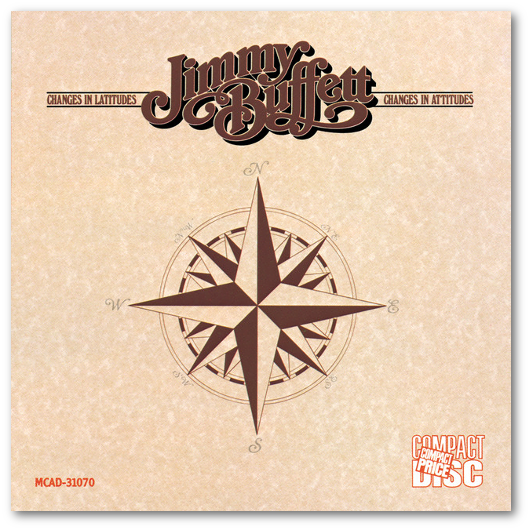
This is the album that catapulted Jimmy briefly into the position of being an FM radio indie kinda guy that had fans but no presence to being what some people would later refer to as a one hit wonder in the country scene. And it’s kind of understandable – Margaritaville is an absolutely titanic hit compared to his normal songs. The song had cross-board appeal, getting to #8 on Billboard, and #13 on Country, which while not unheard of was certainly impressive. This song is not just a classic of the genre but it’s one that kind of became a cultural touchstone for people who went on to become country stars themselves – lots of people reference Margaritaville either by name or by using key phrases, and it’s a song that’s been covered a lot.
There are a few ‘canon’ versions of Margaritaville too, a radio play that’s slightly faster and structured differently, live versions that add different specific references, a kids version Jimmy recorded so his kid could sing along (she’s forty now, mind you). It’s also parodied a lot, with the most well known probably being ‘Marijuanaville,’ a song that is about as clever or subtle as you may think based on the name.
The song’s remarkable to the Jimmy Buffett fandom in that the song is actually a really sad, miserable reflection on how this guy is sad over a breakup and is just drinking himself unconscious repeatedly, whiling away empty days, and at the very end of the song, comes face to face with the fact his situation is his to own and he’s why it sucks. It is sung upbeat and happy and people sing along with it at concerts, and it gives the name to Jimmy’s restaurant chain, suggesting that he’s advertising a great place to go when you’ve destroyed your relationship and end the night being mopped into a bucket.
It also kinda sucks?
I don’t know if this is the Jimmy Buffett hipster equivalent of complaining about overplay, but Margaritaville is to my mind the worst song on this whole album!
This album definitely has more of your 1970s Gulf-And-Western style; songs about being in Mexico or coastal towns, songs about reflection in these spaces where nothing is making demands of you. Where Margaritaville is about a dude wasting his life, Biloxi is a haunting, sunsoaked meditation on a beautiful place, of innocent actions, of the swelling feeling of being in a place that does not hurt. Where Margaritaville is the gentle easygoing rhythm of getting hammered on endless sunsoaked afternoons that don’t matter, Lovely Cruise sings about that with an actual admission of joy, not sadness.
Then there’s In the Shelter, which is already excellent and I kinda covered already, and Landfall.
Now, look, Landfall is a stompy, piano-and-harmonica dance-hall country song that wants to be shouted as much as it wants to be song. It’s got some weird, time-lost joke references (Lucille Ball? Really? Okay, Jimmy), but what sticks with me, the phrase that I realise has been informing my mind for a long time, is where he talks about how being cooped up in a truck doesn’t bother him, being in confined spaces doesn’t bother him, but having to deal with people for prolonged periods bothers him. Running away to the ocean and ignoring people isn’t by any means a thing that scares him, it’s release.
And yeah, I like how singable it is.
I love this album. I’m not sure it’s ‘the best’ Jimmy Album – I put lots of value on West Nashville Grand Ballroom Gown, and Landfall doesn’t have the same potency.
And Margaritaville isn’t that good.
What’s Fanagement?
There’s this term I’ve been using a lot since I learned about it because I feel like people should know it exists. It’s a term that you won’t use and you don’t need to use but it’s absolutely a term you should know exists, because it intersects with your life in a way that you may not even realise, certainly if you’re the kind of person who reads this blog.
That term is fanagement.
Fanagement is a term that was used first by the BBC, describing a strategy they had in mind for what was at the time their upcoming companion series to the Dr Who relaunch, Torchwood. This was around 2005, and yes, Torchwood was fifteen years ago, I’m really sorry to be the one to tell you this timey wimey thing.
Point is that when Torchwood was in development, the BBC were noticing the way that the fans and community surrounding their products behaved, and were already grappling with an established idea called fantagonism – where narratives about the way the shows were made or the way people engaged with a show could result in pushback or even protracted campaigns against their work. The notional argument was that fans had expectations and opinions, and discursive hubs where they behaved and operated, and rather than ignore them or treat them as ‘the outside’ (sometimes called the rat cage!), to take on board what they’re talking about, or anticipating, and implement ideas from fans to strengthen their relationship to the work.
The idea was that while this practice could have results, they didn’t want to just do it with Dr Who – a famously volatile property mostly renowned for being able to spin attention out of budgets comparable to a packet of crisps – and instead, the plan was to use Torchwood as a test for it.
Now, I’m not a Torchwood fan or a Dr Who fan, so I can’t say how well these things worked from the fan perspective, but I can tell you that according to the internal documents boy howdy it went well, so much so that they distributed the paper on Fanagement and started trying to implement the practice widely.

The results of what they wanted fanagement to do was keep a hard core of engaged audiences in ways that metrics could track – so reddit posts, twitter activity, trending on social media platforms. Interestingly, when this discussion comes up, there’s mention of creation of fan works, but not what platforms they tracked – but given the nature of the internet, I have to assume that this means the BBC had someone whose job was to read all the Torchwood porn to see if there was some kind of consistent fan trend to follow in all of it.
Oh yes.
They’re reading our fanfics.
This got a lot of utility too – fan creators that showed promise and ability in the context of the work could be recruited to the BBC’s writing crew, ideas they made that were shared and communal (so not just ripping off someone’s idea, but something lots of people came up with in a deniable way) were harvested, all that stuff. A new Dr Who theme gets implemented, composed by a fan, and they get to meet Peter Capaldi, it’s all a neat symbiosis.
I don’t have it in me to be too mad about the BBC doing this, by the way, in no small part because they’re a publically owned media group. Sure, they’re making profit selling Dr Who stuff, but that’s part of public funds, and so an integration with a public community makes complete sense to me. They wanted to do their best with a beloved fan project, and they were studying the way things got made, and the result was this idea, this term: Fanagement.
Let me be clear, that even as this idea goes places, someone was going to write this down. This idea is not unique alchemy or some poisonous notion. This is something written about by experts in fandom studies! But now that utility, that idea, is being used by people who aren’t using it to guide the production of a beloved franchise of a half-century’s life that has been sustained from time to time by the sheer will of fans wanting to never forget it.
The ideas though have since become accepted as general practice, and the result we’re getting is creating weird things. Weird things like Overwatch, an entire fanagement project that wants to create a non-canon, a sort of big narrative space where you can kinda assume things happen, sorta, or the things they know you like aren’t going to be contradicted, and where most of what’s going on is pure marketing air. Everything is deniable, nothing is written down for good, and it’s all just in motion enough to keep the fans spinning and making all that lovely engagement.
This is something that has struck at Westworld – where a story beat was guessed by a Redditor ahead of time, and they rewrote a chunk of the early show to avoid that, because the idea they should surprise everyone was more important than the idea that they’d clearly laid groundwork that someone could deduce from. Game of Thrones was driven in its last season heavily by trying to implement fanagement strategies, wanting to ensure that everyone got happy by everything they did, and surprise everyone and land the few plot points they knew for sure would happen and in the process created an enormous, long, loud, wet fart of a story beat that, I want to remind everyone again: was bad.
Wrestling, by the way, has had this phenomenon for a while, and there’s a whole book’s worth of content on how wrestling is changed by an attempt to ‘include’ the fans who think they know better (often known as ‘smarks’). Oh, and right now there’s a wrestling fan composing a tweet about how that’s an oversimplification and I know it is, but that’s generally what happened. And the results were kinda WCW.
What I guess I’m saying is if you think that lately, companies have been doing a lot of ‘hey, we get you, fans’ stuff, they are. They get us. They are paying someone to get us.
And those people don’t get us, but gosh, they can fake it well.
4e: Claw Gloves
4th Edition D&D is, like all editions of D&D, very much invested in the physical stuff your character carries around. I’ve talked about this in the past,where D&D finds it easier to use material objects to give you preposterous abilities, even though it’s ostensibly a game about wizards with preposterous abilities. In 4th edition, there was a formal, searchable databse for equipment that meant if you were the kind of player who wanted to find a specific, passive, always-on effect to put on your character, you could always find something to get your hands on – or in this case, in.

There’s a bunch of items that are designed to be Heroic tier prizes, items that are pretty cheap and have a really nice effect, but don’t scale up at all, usually in a slot that is either hotly competitive (arms) or tends not to matter much (boots). These items in Heroic tier are really nice – often things like Rushing Cleats or Badge of the Berserker will serve you really well and help you shape your character as you level up.
Claw Gloves are designed for druids, which is why they reference a specific keyword that druids get, ‘beast form.’ If you have claw gloves on, and you’re in beast form, and you have combat advantage against an enemy, your melee attacks are improved by 1d10. Combat advantage, something you already want, becomes extremely desireable when you’re dealing chunks of extra damage, and this is a passive property, meaning it’s not a sometimes food. Any time you can make those things happen, you have the extra damage.
For druids, that’s great, making their beast form – already a control monster – into a really strong damage dealer in Heroic. Claw gloves are great.
Thing is, Druids aren’t the only ones who can get access to Beast Form, and thanks to the Werebear, Wererat and Werewolf themes, every other class can have a ‘beast form’ mode to their melee attacks. Once you get out of Heroic, into Paragon, the lycanthropes can just ‘always’ be in beast form, meaning there’s no reason to drop out of it, allowing for full time furry character interpretation (and it lets you define yourself how that looks). This means that suddenly, Claw gloves work just fine for Fighters, Rogues, Rangers and Battleminds. Anyone who does melee attacks and multiattacks gets a lot scarier when this one very cheap item in an underused slot is pumping extra d10s into their attacks.
What’s more, once you commit to going ‘well, claw gloves look cool, can I use them?’ you wind up at beast form, and then all those beast form feats stack up, and you’re suddenly presented with, say, a Werebear Grappling Fighter who tucks enemies under her arms as she wades across the battlefield, and when they try to escape she crushes them then throws them across the battlefield.
Claw Gloves are great, numerically, but the thing is that they serve as a thread you can search through for building your character, and that’s exciting. What’s more, if you don’t want to do that nonsense, you can just get handed the item, go ‘oh, that’s not for me’ and move on.
In conclusion, fear the furries.
The original art for the claw gloves I used is from a store called Stronghold Leather that appears to have since shut down and the only remnants of their work remains as pinterest boards.
Game Pile: Newfoundland Jam
Hey everybody, let’s make some friggin’ jam.
Two Player RPG Idea
Over on Reddit in February, someone asked about the idea of two player RPGs – the notion of a RPG system where players take turns in the Gamemaster role. That’s all I got – just the basic question of is this a thing?
And well, that was interesting. I thought about it.
The absolute first thought though, was that in the right pair of players, you don’t need anything new or different. Lots of games can be easily adjusted so the challenges can handle a solo character, players can play multiple characters, all those typical ways of dealing with absent players works fine. Barring for games that require voting (and those aren’t that common), there’s nothing that doesn’t already work.
This is a solved problem for players who want to just play D&D and can swap things back and forth with no problem. You could do it super episodic, too! Imagine a Scum & Villainy game that essentially worked like Star Trek: The Next Generation, where each week you swap storyteller to deal with a new thing.
Still, I do see a problem with this: Maintaining suspense and surprise. How do I make sure there are plot elements and narrative beats that handle the give and take of storytelling, and make for a long-term narrative where I can be surprised by things I put into the story without necessarily having stories I laid the groundwork for changed out from underneath me?
While I don’t have a system, I have an idea for a mechanic that can give the game some sinew.
And it involves playing cards.
Wait, wait, don’t go!
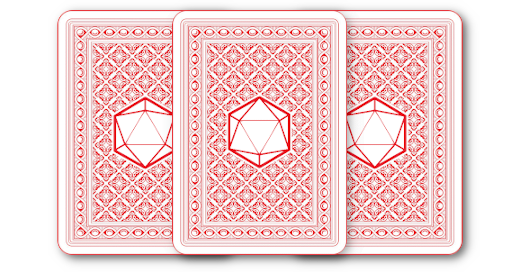
Okay, the idea is you start out with a deck of ordinary playing cards. This is important because you want something that’s reasonably replicable where it doesn’t matter if the object goes away. It can be destroyed, it can be damaged, and it can be written on.
This deck of cards is going to be the interaction of elements that each player can use in their section of the story they’re DMing. When you introduce something you want to make important, or when a player indicates in a session that they want to come back to something, the players take an unwritten-on card, write that on a card and put it back into the deck. Then, when the time comes to exchange control of the DMing role, the new DM draws a few cards and sees what stuff in the story is available to them.
This gives you a way to be surprised when things come back, and it takes some of the long term structure away from the players in a way that makes both players uncertain in an interesting way.
You can write more on each card as things happen; you can use this when a plot changes or transforms something, you can edit its card, and shuffle it back in. You can even do ‘trades’ – where a DM may want to ‘save’ something for later.
The cards can be used as action points too to smooth things over – take a few cards off the top of the deck, and the player can use that card to make rerolls, or abrogate special abilities, or survive things they wouldn’t – and then adding those cards to the DM’s pool of plot tools. So you might want to avoid letting a baddy get away so you spend a card to tackle them – but now that card gives another plot point to your DM for later.
New Keyboard
Right now I’m typing this blog post on a new keyboard. This is the keyboard that comes with my new laptop, which is a combination multi-family christmas and birthday present. This is, by dint of being purchased new, and now, now the most powerful computer in the house.
This has brought with it a bunch of infrastructural thinking. I have to set up a new laptop and that means managing logins and synchs and wondering just how badly I need this thing that I have to set up if I want to keep using it. It’s not a bad time – not really a bad thing to do a single big infrastructural audit. Do you need what you’re telling yourself you need? How many directories are full of accumulated nothing? How many look unsorted, but sorting them would be unnecessary?
Software changes and updates are interesting, because they’re these kind of virtualised things. Updating and changing them, that’s a matter of restructuring ideas in my head. But fixed to this computer is the new keyboard.
And that is what I have to just learn to use.
There’s one big change in this keyboard – some keys are going to be rarely used, which means using them will involve calling up a check in my mind. But some keys are used so much they’re basically being put together intuitively out of impulse action. That’s where stuff gets weird. Because on this keyboard, the ctrl key is split into two parts; one is a ‘function’ key and one is a ‘ctrl’ key.
And the ctrl is on the inside of the pair.
It’s remarkable how difficult this is proving to adjust to.
Martens!
Martens are a grouping of small, fuzzy predatory animals that populate most of the continents in the northern hemisphere. They’re in that category of animals that are uncommon enough that our major point of comparison in European culture is to compare them to things they’re not like, so the comparisons tend to be ‘like a cat, but.’
It’s possible that you’re aware enough of animals to know about ferrets or skunks, and those are the better starting place to talk about martens. They are mustelids, the category of carnivorous mammals that includes otters, badgers, wolverines, and weasels. If you’re curious about how we tell ‘mustelidity’ in things, well, these days we do it with cladistics, rather than just squinting at the animal’s bits, but there are some common traits. Mustelids tend to have elongated bodies, short legs, round ears, and thick fur, which is also why probably the most high profile mustelid is famous for being separated from its fur – the mink.

Martens are forest-dwelling predators that seem to thrive well enough in spaces where there may be territory but not necessarily a lot of space. If you go to a Russian taiga, you’ll find martens there – unable to make large, elaborate burrows in the cold ground like a Badger’s set, they instead run around along tree branches, jumping and bouncing and holing up in small hollows in trees, using the way their bodies are flexible and bendy to make comfortable resting places in ridiculous positions.
We once kept ferrets, and they had this same trait – you’d sometimes find one, curled up in a loop, feet in the air, nose to butt, able to make themselves into a sort of fanged donut any time you left them with something to nestle into. Martens live in these environments by predating on smaller mammals like mice and shrews, hunting birds – which they can even do by springing into the air from branches – and stealing eggs from nests and honey from hives.
Martens are currently ‘least concern’ level of endangered, and they are very cute. They are not domesticated and it is not advised you approach them if you see one in the wild.
Why am I talking about this?
Because it’s MAR-10.
Story Pile: Odds & Ends
Header image source: pixiv, by @maguro8989
Today, in Australia, as this article goes up, it is March 9. In Japanese, you can pronounce three ‘mi’ and you can pronounce nine ‘ku’ – meaning that the name ‘Miku’ can be seen as 3-9 – or the 9th of March. Inasmuch as Hatsune Miku, the cybernetic girl, the meme, the idea, the artistic influence and movement of artwork unto herself could be said to have a day, this is the one that people have chosen and so, it is the day we’re doing this.
Reproducing Pictionary
If you’ve played Pictionary in the past ten years, hold on, just, you know, hold on.
Okay, so I played Pictionary when I was a little kid visiting friends a thousand miles from our house. It was not a great game – I never was that into it, I wasn’t very good at it, and it had a board that you had to roll and move around, which meant there were often long periods where you were watching people do five or ten minute long ‘turns’ while they bickered and argued about the drawings and so on.
Similarly, one thing I try to do now as an adult is think about old games I played, and if I can improve on them. It’s very basic, methodical kind of work: What did or didn’t work about this game? What failed, what succeeded, what needs more attention, what was just always going to be bad? Can these mechanics represent something else? Crucially, when looking at older board games, I ask myself: What can be taken away?
With Pictionary, the idea I had was that the first thing to take away is the board.
Right?
You have a deck of cards, they give you secret information, that’s heaps, that’s all you need. You can even use the cards to do something random, but, you don’t even have to. You can make the game about rolling a dice and looking at a card, and right there, you’ve got a rudimentary design.
The idea I belted out was as follows:
- The game is played with drawing paper and tools, a deck of cards, and a dice.
- On your turn, you roll a dice, look at a card, and then that card presents you with a number of options, with your number roll giving you a priority.
Each card has seven options on it; one in each of the categories – let’s say they’re like:
- Person
- Place
- Animal
- Object
- Action
- Internet
With another category that says Bail.
You roll the dice, you pick one of the things to draw, and if you draw the thing that the number rolled, the card’s worth bonus points. This way you’re pushed towards an option but not screwed. There’s also the ‘bail’ option where if none of the options are good, you can offer this card to the whole table so everyone can try and draw the ‘bail’ option.
Just like that, I have the outlines for a card game. The timer becomes a problem! But a physical timer, a dice, and a bunch of cards takes up way less space than a big board would and you could fit the whole game in a tiny space, almost Oink Games style! Or you could make the game print-and-play, or even give out a template for people. And if you’re a teacher, you can just use a big ole list of random flash card words where they have to draw the thing, then write the name to show they get what it is! Teaching supplies probably feature whiteboards and markers, so you can repeatedly use the same drawing space over and over instead of paper and pencils!
Would I make this game? No, probably not. It’s not a terrible idea, and it certainly seems doable very easily, and may even sell a few copies, but the nature of it is that it’s just making a shelf filler.
Now.
The punchline.
Turns out the copy of Pictionary I played in the 1990s was from… 1985 or so. The great big box, the board, the roll and move? That stuff’s not really part of the game any more. In fact, if I’d looked at a copy of Pictionary from the last ten years, I’d find a game which is just cards, dice, timer, and whiteboards and whiteboard markers.
I choose to think of this as convergent evolution, of sorts, and that’s kind of good. It’s definitely for the best – it’s a way to show that Pictionary with a board can handle losing the board. What’s more, it also shows what I was considering and experimenting with: I wanted to deal with chokepoints and friction. That’s great, I can deal with that.
It doesn’t fix one of the biggest problems with Pictionary, even as it reduces the game design I’d made to a super-simple, tight version that I could probably sell for $15 with hundreds of possible game states (Which seems fair to me). What it doesn’t fix is that if you can’t draw, this game sucks.
Fortunately, Pictomania, by Vlaad Cvhatil, does solve that, by making the drawing and solving concurrent; you draw until you’re as good as you’re going to get, then you do your guessing – and guessing correctly first is more valuable than getting all your work guessed perfectly. This creates a tension for drawing ‘as well as you can’ but being okay when you stop.
Dicebuilder Diary and notes
Custom dice are cool! They’re also expensive to manufacture. They also let you do weird things like have uneven roll pools? That’s neat. If you’ve ever seen the dice in Betrayal At House On The Hill you might know it’s got dice that are numbered 0, 0, 0, 1, 1 and 2 – that’s really mean!
You can do a lot with dice rollers! There’s the town builder Machi Koro, for a famous one, and there’s the set collector Yahtzee, a familiar roll-and-write. You could look at our own Cafe Romantica, where you build a collection of cards that react to the dice you roll. The thing with those games is that even though ‘these cards react to these numbers,’ and it actually works a lot like just flipping cards, by using a dice you can have multiple things respond to the same cause. There’s stuff you can do, it’s all interconnected, all fractal.
I’ve been thinking about this mechanic. Making custom dice is a bit expensive, but exploring an alternate way to do it resulted in me making a thing that I like as a possible space:
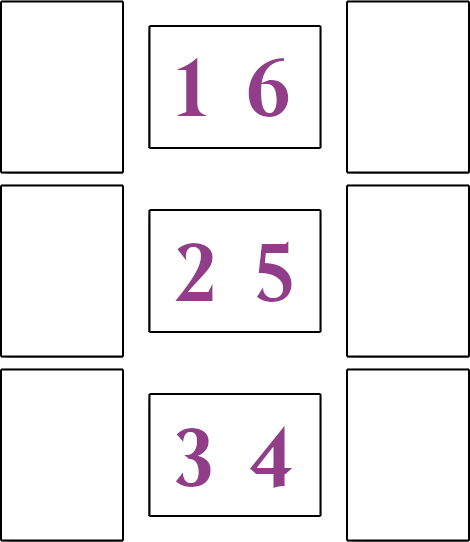
In this case, you play the game with a starting d6, maybe one for each player. They roll dice, and, then the numbers rolled result in the cards in those slots firing. It can be set up so that lots of cards are piled up on each number, so you can get lots of effects on single rolls and so on.
I want the building element of the game to take priority over the rolling though. That means whatever the design is, I probably want it so winning and losing isn’t about what the numbers rolled do, but is much more that dice limit your opportunities. We want winning and losing to be about choices you make in the last few turns, not about whether or not you rolled the Dead Dice.
I’m looking at this design and thinking of different flavours and different game sizes.
- if the game is very small, you probably will wind up with all the cards set up. This might make ‘victory’ about possibly picking a loser you’re trying to make sure that whatever you roll, you’re not in trouble, and someone else might be. Each card is probably unique.
- If the game is mid-sized there’s room for more permutations of cards. This might mean that you’re trying to roll combinations of things, possibly to build something else?
- if the game is big, there’s room for things like faction decks, where each number rolled represents improvements on types of things, or progress or success for groups of enemies or gangs. This could be seen as a sort of economy or electoral game where players are responding to the random actions of an entity like a population or a city.
What I’m thining, looking at this prototype is that I want every player to roll dice at the same time, and then players select a number of dice – so you can ‘leave’ someone with dice that may or may not be appropriate to what they want.
I think there are two games in this engine – a smaller one and a larger one. The smallest one is probably a game that wants to focus on the potential viciousness of rolled dice, a meanspirited thing like You Can’t Win. The larger one wants to have more of a solid theme.
Just some notes and thoughts.
Game Pile: Sushi Go
Sushi Go is a Gamewright card game defined by a charming visual aesthetic of cartoon sushi pieces going around the table as a sushi train. Each turn, you take a piece from the sushi in front of you (your hand), and pass the rest of your cards to the next player, representing a rolling line of sushi that you can pick and choose from to cultivate a plate of complementary flavours. There’ll be some things you don’t quite want as much, some things you enjoy, and in the end, the stakes for winning or losing are all very low.
Just How Bad Is The US State Flag Problem?
I time to time do flag threads on twitter, which are great for the format of twitter, which is fantastic for the framing of ‘here is a picture, now I will be mean to that picture, and as you scroll, I will do it again.’ Blog posts about flags tend to be a bit more laborious, because I feel the need to provide contextual explanation, which, you know, that’s not a bad thing, but it does change the tone.
If you’ve paid attention to me talk about flags, yeah, a bunch of this is going to sound familiar, but I feel the need to make a primer.

When you start to talk about a problem in a group, it’s very easy to start making concessions for that group. In the context of the US State Flags, there are fifty of these suckers, and fifty of anything means it’s just naturally, intuitively easy to think ‘oh hey, surely this isn’t better or worse than that.’ The problem that arises is that when it comes to flag design principles, there are three very simple rules that you can follow.
- No text
- No fine detail
- Limited colour palette – three to five colours
And for Americans, we can add a new extra rule:
- No confederate flag stuff
Now, is South Carolina’s floppy mop better than Washington’s woodcut? yeah, probably, but it’s still a fine detailed flag. Having fewer mistakes than the other doesn’t mean it doesn’t have mistakes. And these mistakes are the kind of mistakes that simply gets a design a failure. Go back, start again.
A lot of these flags weren’t designed with these things in mind – in fact if you dig into the history of a lot of them they weren’t designed by people who make flags at all, mostly being the result of state lawmakers who wanted to try and leave a mark on the state, or graduate some existing element of the state’s iconography into the big leagues. Very few of them have been seriously reviewed and a number of them are influenced more by Chamber of Commerce members in the state than anything else, which if you don’t know them, they’re kind of like social clubs for local corporations. Not great.
If you take this list of sins, and remove every single flag that breaks one of the rules, this is what you get:

Out of 50 state flags, there are seven that don’t break one of those major rules, by featuring either confederate imagery, text, fine detail or a too-deep colour palette.
This is a problem that gets worse. When I did my flag thread by city flags in America, I had to invent a new category for flags that weren’t just bad because they broke one of those rules, but because in addition to the rule breaking, they broke those rules to create something awful. There were a whole category of flags in the US like Belen’s old flag:
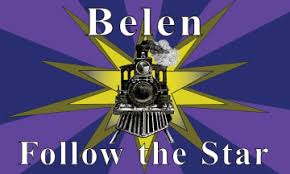
This thing looks like it was made in Corel Draw. It’s not just fine detail but it’s fine detail you need a clipart library to replicate.
This is what I mean when I talk about American state and city flags being bad: So many of them are so bad they need multiple categorical levels of types of failure to make sure I can convey that I’m not just being randomly mean to things that don’t meet my personal aesthetics, but that they are doing things that push them into the realm of inventing new mistakes.
Meanwhile if you’re curious, hey, Belen updated their flag, to this:
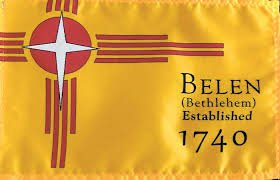
This flag is better, but it still breaks the rules.
Bonus: It’s being protested because it’s promoting religious iconography.
cool flag work, Belen.
The Epic Level Handbook (3E)
When it comes to D&D books, you’re talking about what amounts to academic reference material. That’s not a slam on the game, of course – I’m not objecting to the games or the playability of the game, as if they’re now these dusty tomes that are only meaningful in a sort of hypothetical framework. It’s more that the books are literally designed to be reference material for a specialty field. These books are dense. That can present a challenge in giving someone who isn’t already versed in the game a way to understand that book. Do we talk about specific chapters? A point by point analysis? Do we look at just an excerpt?
I think in this case, at least for now, what we want to talk about here is an overview of the Dungeons & Dragons 3rd Edition Epic Level Handbook.
This book is a punchline.
Continue Reading →Recognising Your Limits Of Knowing
This one’s going to feature some chatter from me as someone in a privileged position talking about people who lack that privilege. Just a heads up.
Recently I did a video article, where I mentioned that the idea that the main character of Fire Emblem 3 Houses could be read as autistic. At the time, I mentioned this was something I’d absorbed off other autistic friends and even mentioned one of them by name.
In the same week I recorded that audio, I introduced a early-transition trans girl friend to the idea of doortitting, where early on in transition, many trans girls misjudge the weight of doors and whack themselves in their extremely sensitive chests in a way that can be super painful and rough.
In neither case are these my experiences; all I’m doing is giving voice to things I’ve learned and heard from multiple other sources, and I try to make sure when I do these things I’m making it clear that I’m speaking of things I learned. There’s a gap between knowing and learning, after all.

Dara O’Briain in one of his comedy sets once related a story where an incensed Christian got mad at him for making jokes about Catholics, but that he didn’t have the courage to make jokes about Muslims. Dara’s response was that he wouldn’t tell jokes about Muslims because he didn’t know anything about them, and neither did his audience – there was literally no way to make a meaningful or funny joke from that position of complete ignorance, and admitting that ignorance was important and powerful, and it highlighted to me at the time the idea of how people are sure they know things when they don’t really. He then related a string of nonsense that may or may not be related to actual, obscure Muslim traditions and the point of the bit is I don’t know what he’s talking about.
There’s stuff I don’t talk about because I don’t know about it. I don’t talk to a lot of black women, for example. I can read black women’s work and I have indeed done so, learning amazing things about what Robin Boylorn calls blackgirlness, but that’s reading from an academic source. That’s not ‘my friend talks to me and I absorb culture through them.’ This means I’m typically resistant to commenting on black women’s issues except in the broadest way that hey, we treat black women real bad, that sucks, let’s stop doing that. When it comes to trans dudes, I talk to fewer of them than I do to trans women. Ace and autistic people are more common in my sphere, and that means I often think about the concerns they raise.
I think it’s important, and very healthy, to work out what it is you don’t know much about, even if not to fix that because you don’t want to approach friendships with an air of ‘You are my research assignment who will make me less ignorant of say, Southeast Asians,’ but just so you can be comfortable and confident admitting two crucial and important things:
I learned this from…
And
I don’t know.
These are invaluable tools for keeping your mind working well. Connect what you know to the people who did the work, and admit when your knowledge fails you.
The other thing is, and this is very important, even if in single direction relationships like where you’re reading a twitter feed of someone who doesn’t talk to you (like a big name activist or the like), is try to ensure you have a plurality of voices of types around you. When you listen to one black person, one gay person, when you’re not listening to marginalised voices but a marginalised individual, you’re making it harder for you to get interesting, meaningful, nuanced perspectives on these groups.
And when your media feed is one trans woman, you’re going to get that one trans woman’s take, and that, as we’re seeing, has led to some really rough stuff when people who listen to one trans women ignore all the other trans women who disagree.
Story Pile: In the Shadow of the Moon
Okay, so we have to establish up front, and this is important, that talking about what’s going on in this movie is going to involve spoilers. And just by telling you there are spoilery topics at work in this movie, you’re immediately going to have reason to go ‘oh what about X or Y’ and you may fear, in some way, that your enjoyment of this movie is spoiled, because there’s something really thoughtful, and clever, and cool in this story that you’re going to have to now feel is somewhat tainted, somewhat weaker and I may have, as it were, spoiled that for you.
Good news: You don’t have to worry about it, because this movie suuuucks.
Round Friends!
Mid February, I ran a set of polls attempting to consider exactly what Pokemon could be considered to be round. The premise was pretty simple: if you were limited to a gym leader whose theme was round pokemon, what were your options, really? And if you could do that, would what you got have a chance of being competitive? By what standard? Is there a power trend connected to roundness?
I had some hypothesis ahead of time. First, I thought that a round Pokemon team would have a lot of slow, tough pokemon, and probably would be biased towards water. But that’s not scientific, that’s not a science. That’s just umming and ahhing! That’s guessing!
The problem is that roundness is really subjective, and while I could make the judgment calls, it’s probably easier to have a lot of self-styled experts vote. That way, no roundness is my opinion, it’s all a collective take from a larger group. There are eight hundred Pokemon, though, so asking for all of them was just too much work and people would lose stamina quickly. That meant making a general selection, and letting votes sort out which things did or didn’t belong in the group.
I’d need to make sure to present as many options as I could, to make sure that I wasn’t excluding something I consider an edge case, and let the voting do the elimination for me. Also, this would eliminate things from the group that didn’t belong, but it couldn’t bring things into the group I hadn’t mentioned.
The original list and votes is available here, in this twitter thread, and once I had that done, I made an excel spreadsheet to put together that information in a usable form. Specifically, I wanted to make sure I dropped all the ‘neutral’ votes in case there were some votes that were swayed by that one way or another, and I wanted to know which Pokemon got the most yes votes, even if they didn’t necessarily have the largest percentage of yes votes.
Twitter polls degrade over the course of a thread; I expect that the earliest pokemon to vote on would get the most votes, and therefore probably the most contentious opinions. For comparison, in this thread, the Poke that got the most votes (Ditto) got 275 and the Poke that got the least (Phione) got 108, meaning more than half people didn’t reach the bottom of the thread.
Finally, I had to have some kind of a cutoff. My notion is that if a Pokemon got more than 50% ‘yes’ votes on its roundness, it was round. I didn’t want to define roundness, but would rather let roundness be extrapolated from the vote. This limit then presented a barrier between ’round’ and ‘not round,’ a roundary if you will.
What did we end up with?
Well, we got a graph.
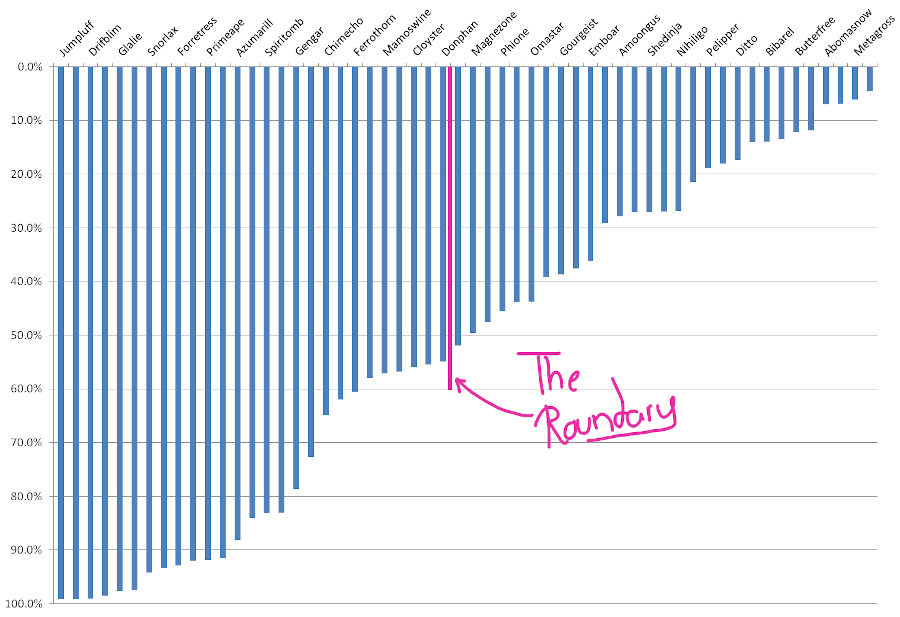
In our list of 56 pokemon, 28 were considered below roundness, and mostly the Pokemon that are round are very much considered round. The grouping that hang around the middle are Pokemon with what looks like a reasonable degree of contention; after all, Donphan is considered round, and Magnezone isn’t. Corsola is comfortably Very Round (72%) while Cloyster is much more contentious (55%), but the two have very similar silhouettes. Aegislash’s primary defining visual element is a circle, while Donphan is an elephant, yet the former is ‘not round,’ and the latter is. Donphan does roll up in a ball, but neither Miltank nor Scolipede crossed the roundary, and Donphan did.
Similarly, Jumpluff is almost the roundest pokemon voted on (99.2%!) and Weezing is similarly heavily round (91%) despite the fact that neither of them are even vaguely spheres – they’re made up of spheres stuck together.
Some traits of roundness then, by observation:
- Smiling! Pokemon with visible faces that smile seem to be Round
- Face-as-body! If your whole body is occupied by your face (Corsola, Glalie, Cloyster style), you seem to be seen as round
- Limbs are either/or. Primeape and Snorlax have limbs, and are round, but Miltank has limbs and it’s not.
- A round feature isn’t enough. Wailord, Magnezone and Aegislash are all ‘not round’ despite having that absolutely being the dominant shape of their bodies
Now, you might wonder to yourself, where’d this idea even come from? Well, I went and did some personal archaeology wondering about where I got the question of ‘what would a team of roundybois look like,’ and it turns out it was this tweet from one Sav Wolfe, from back in 2018. Yes, I apparently keep thinking about tweets a long time after they pass.